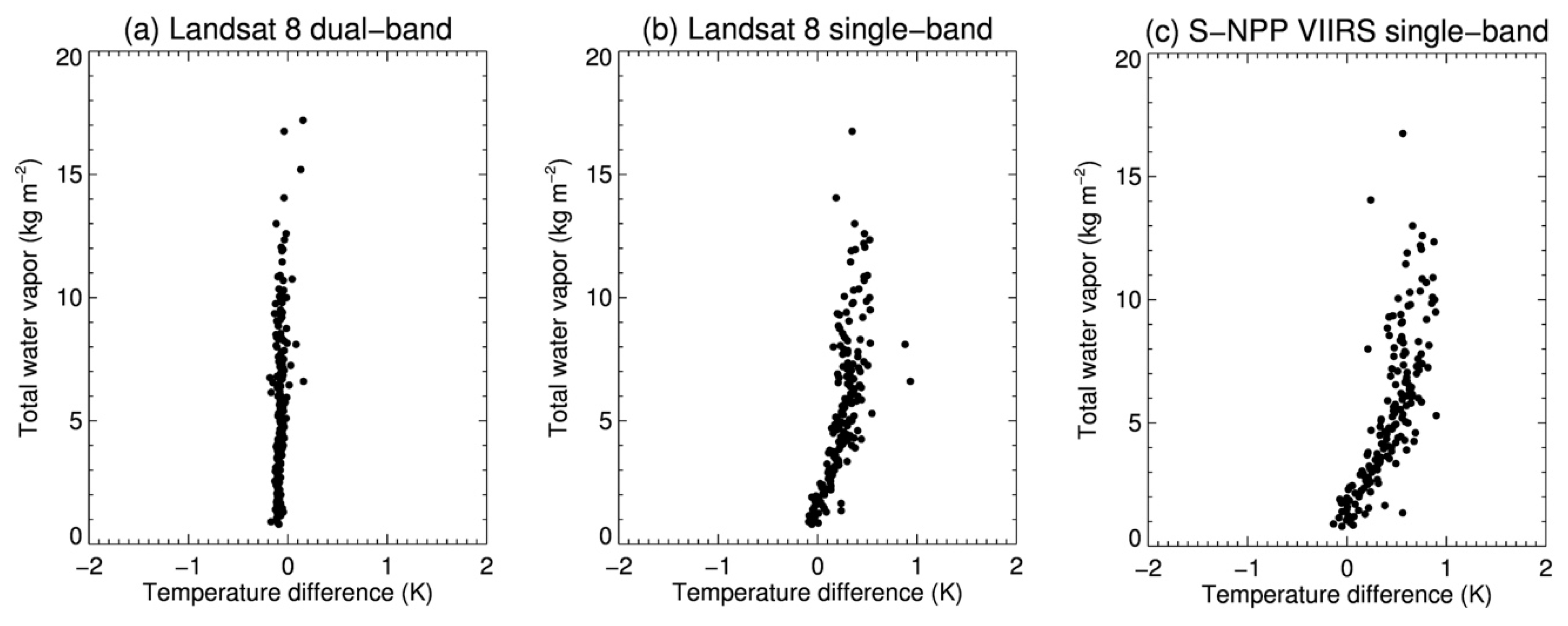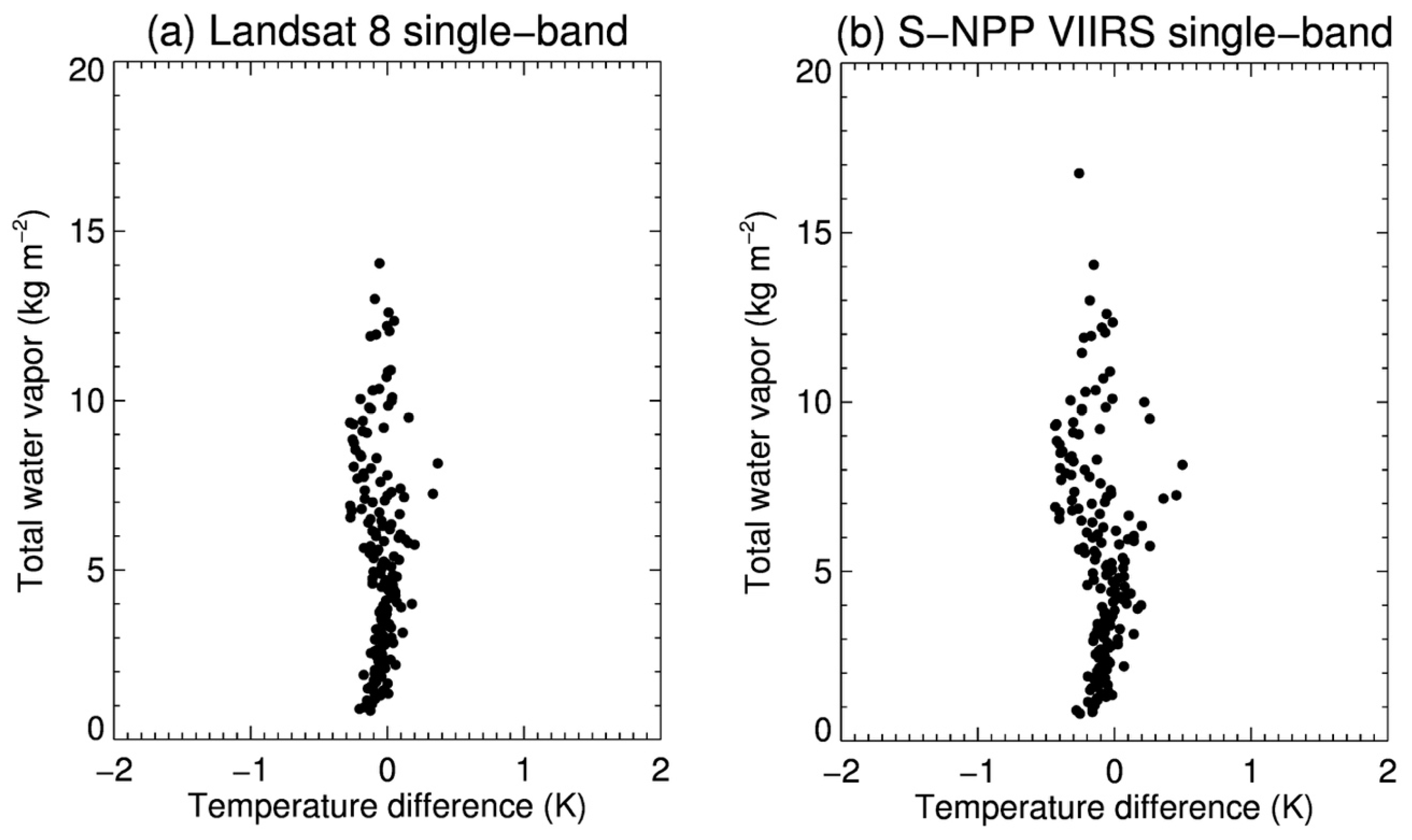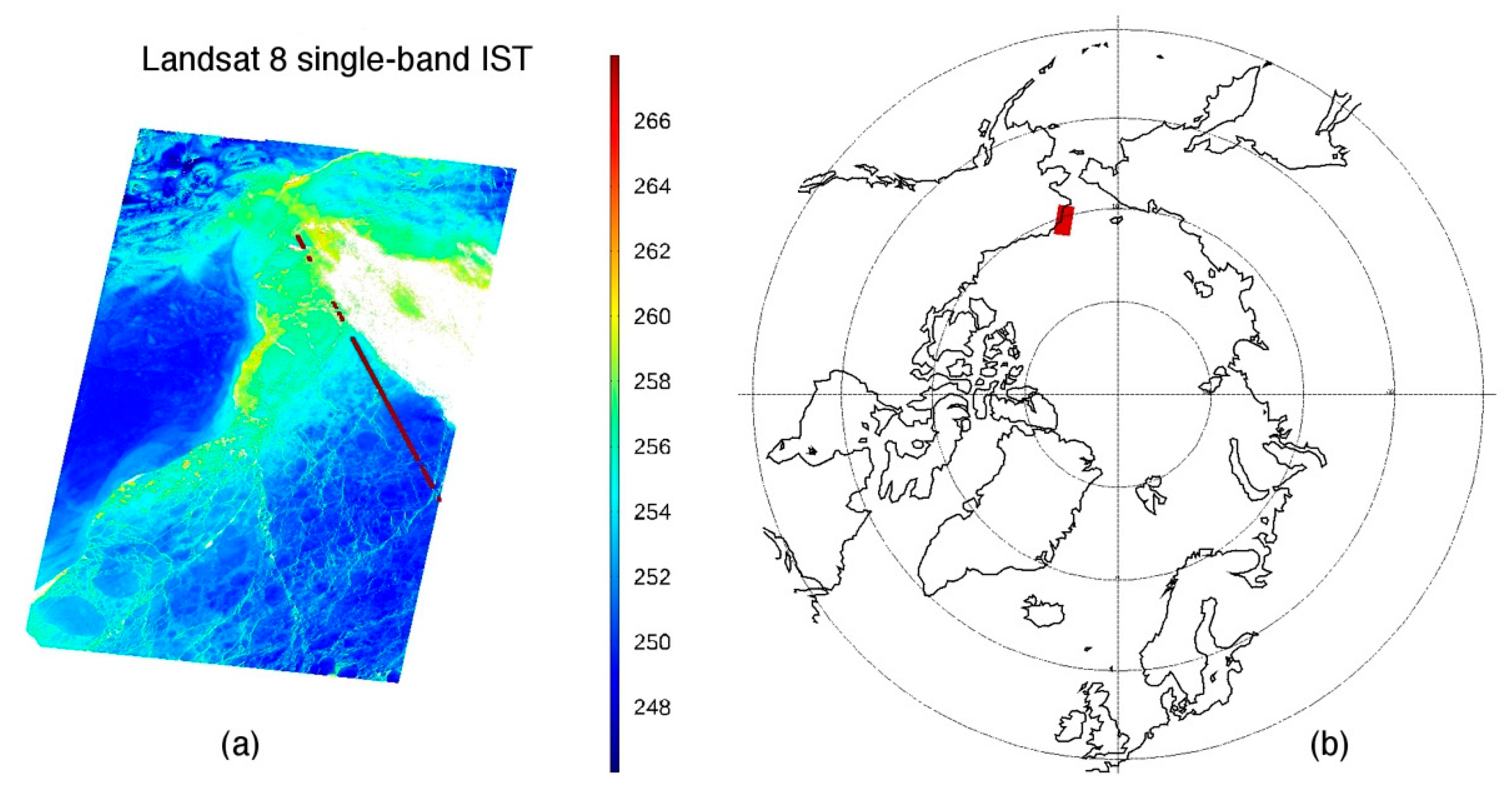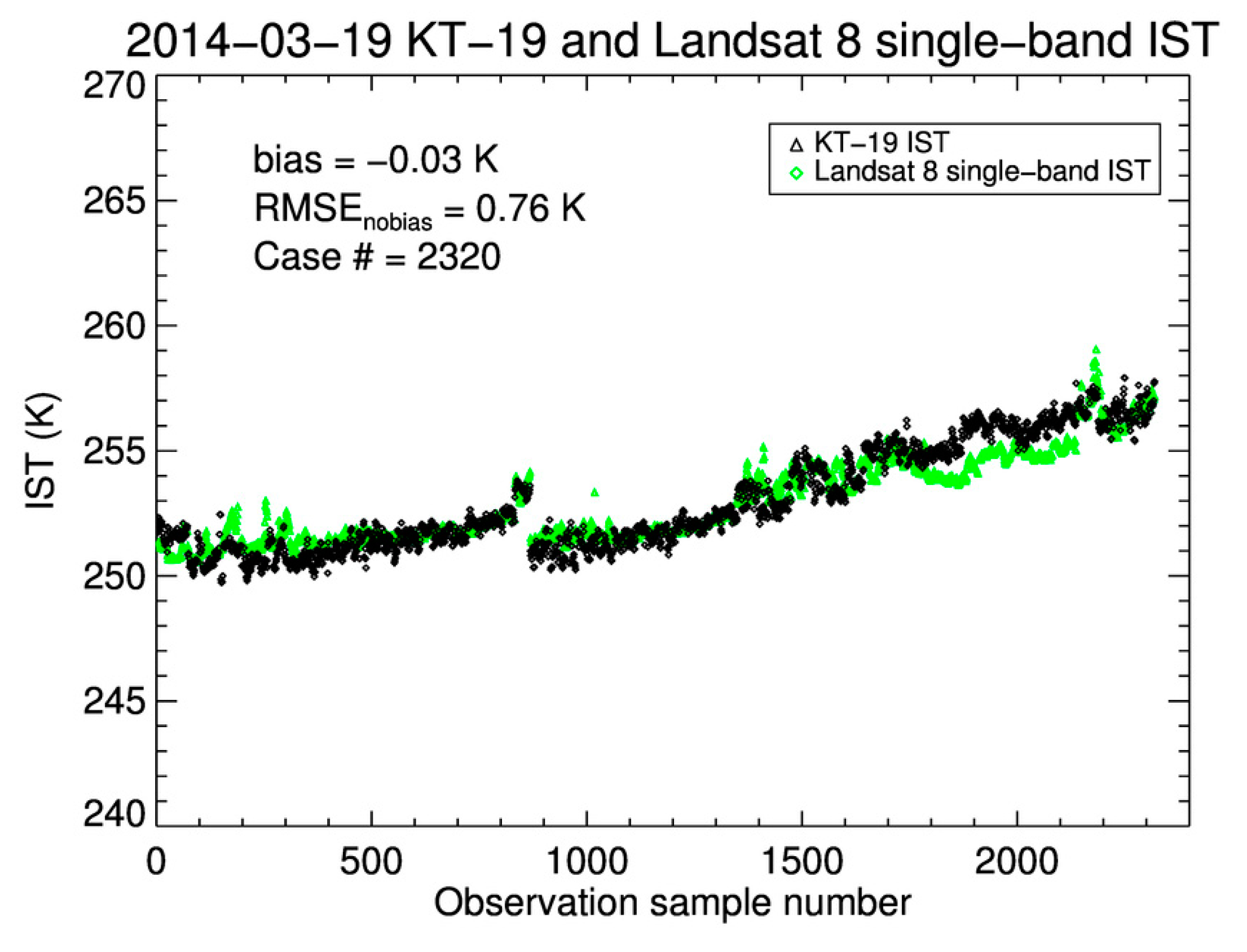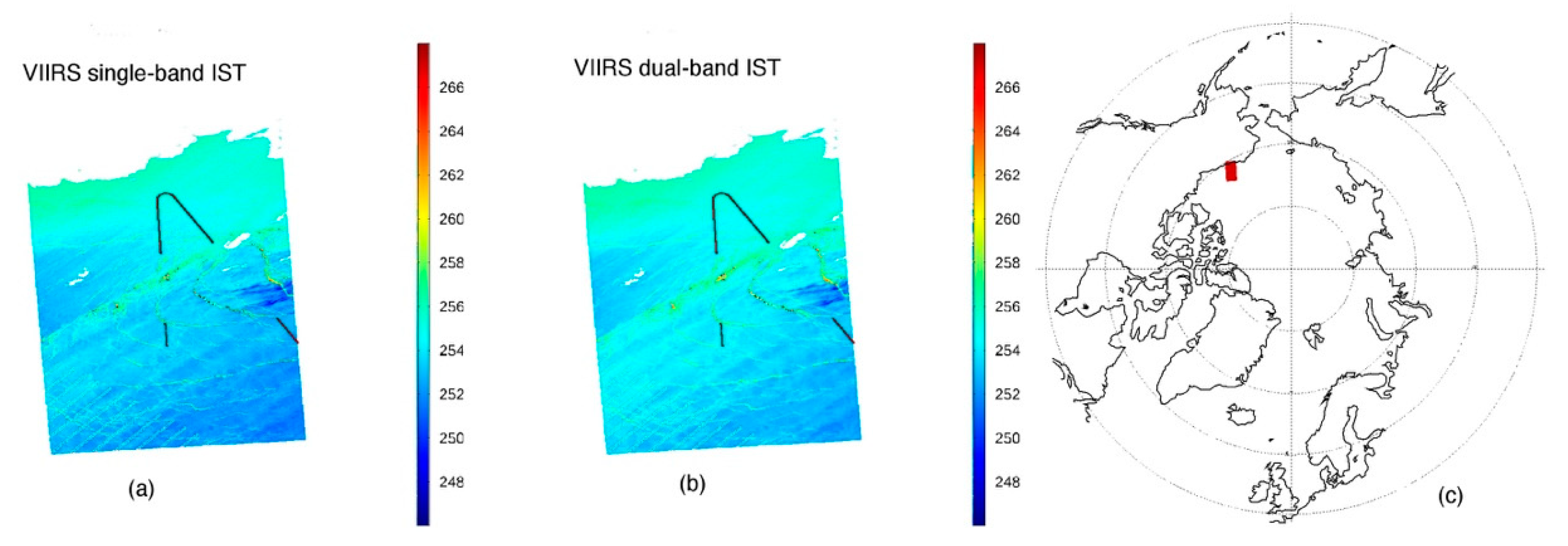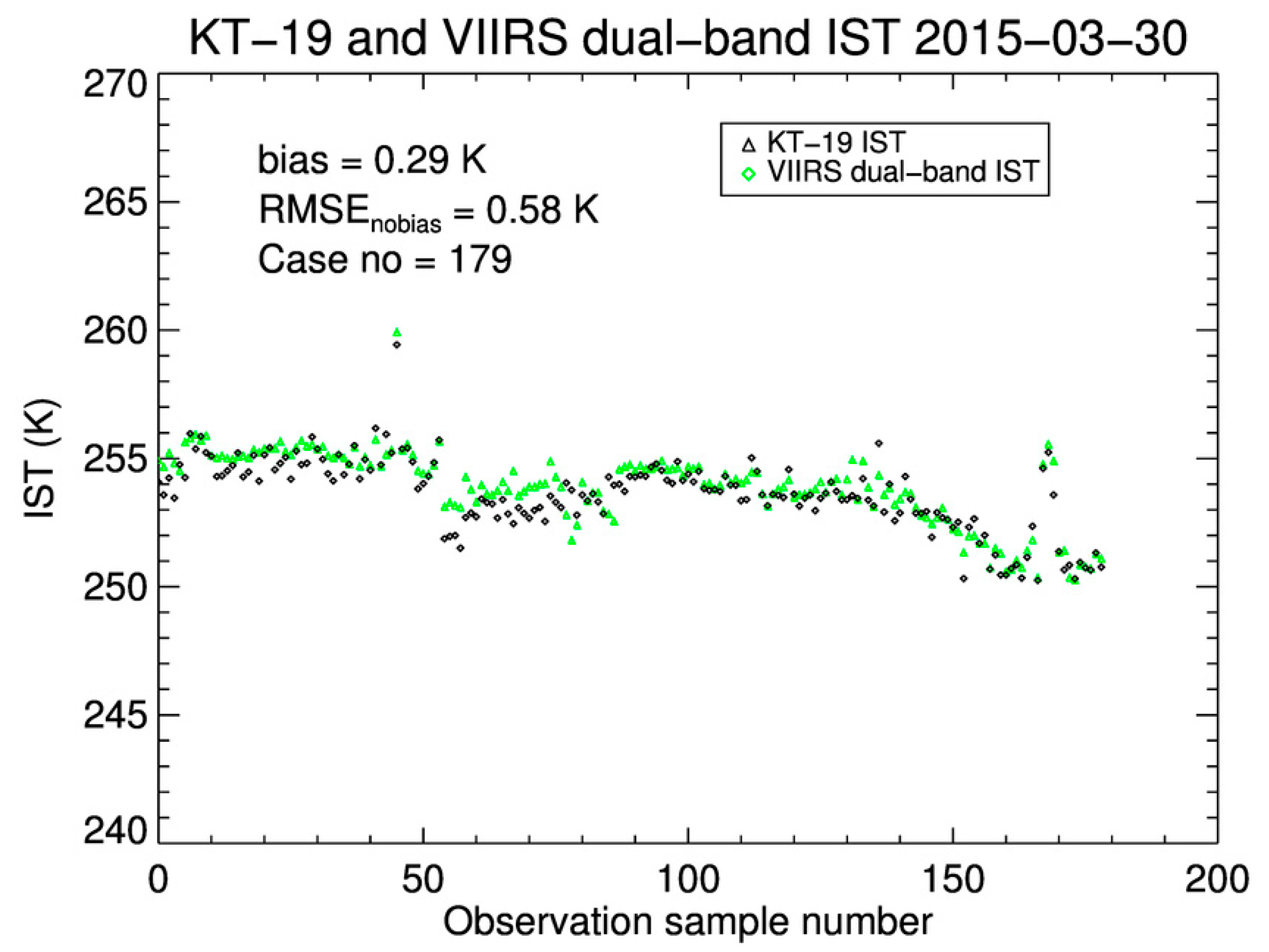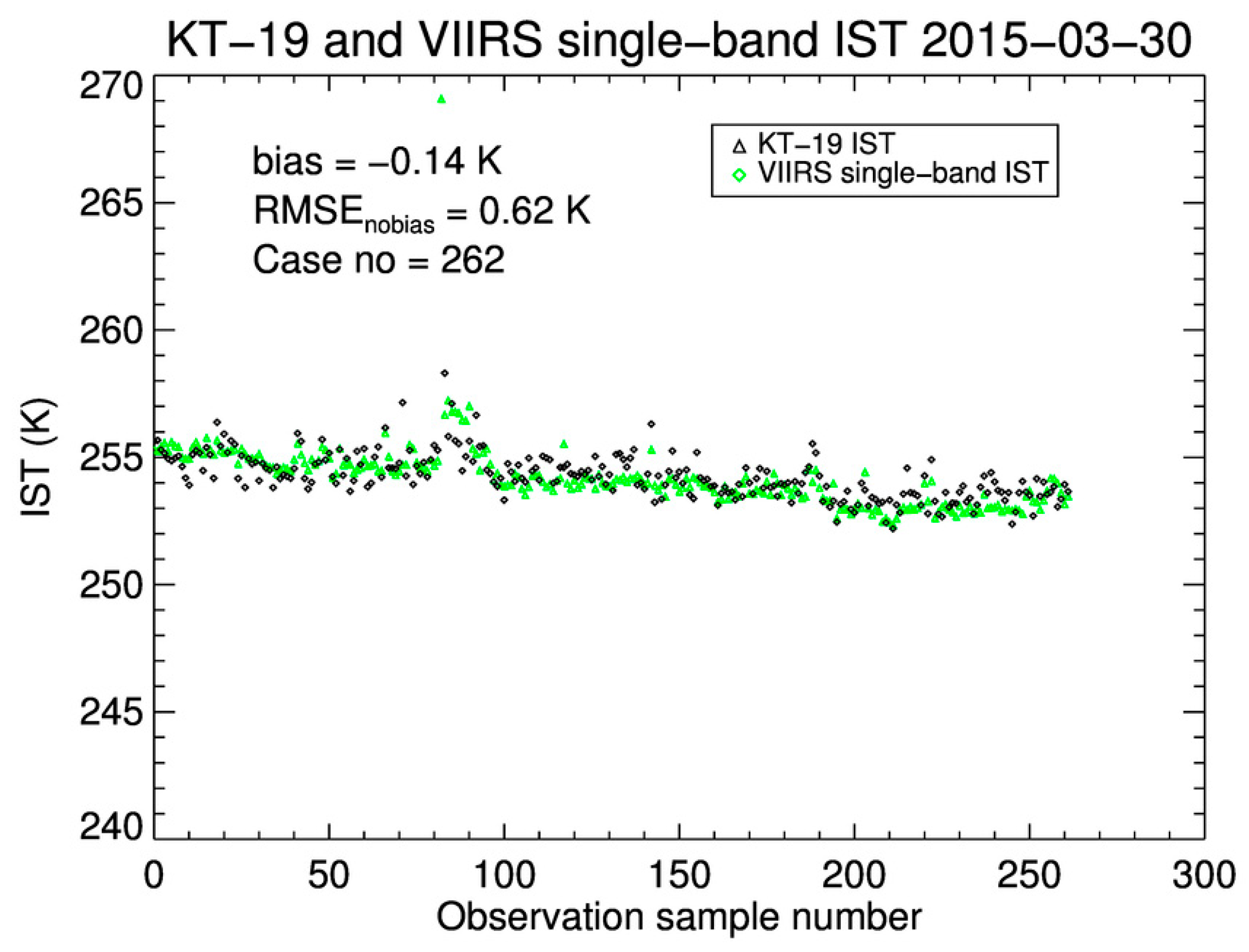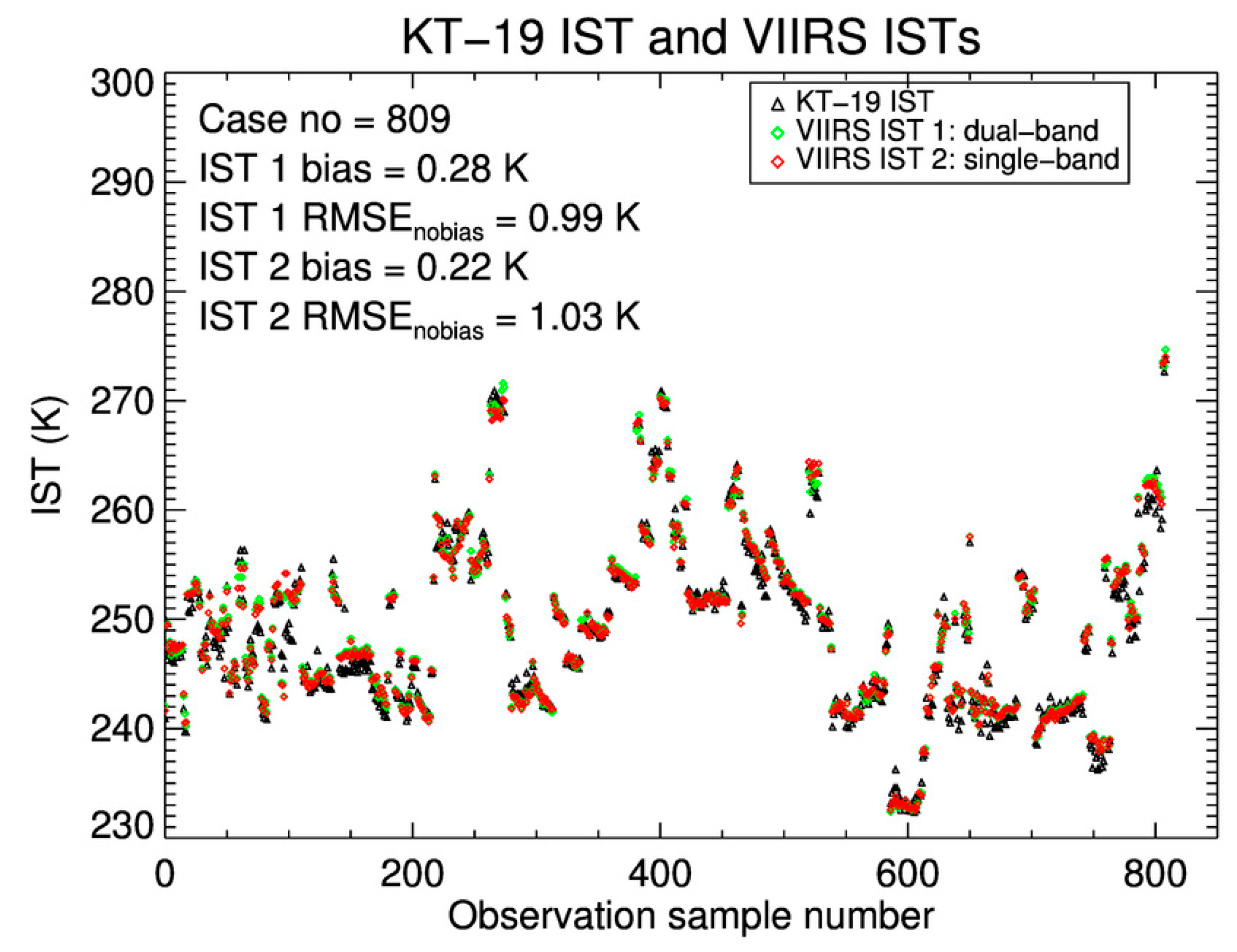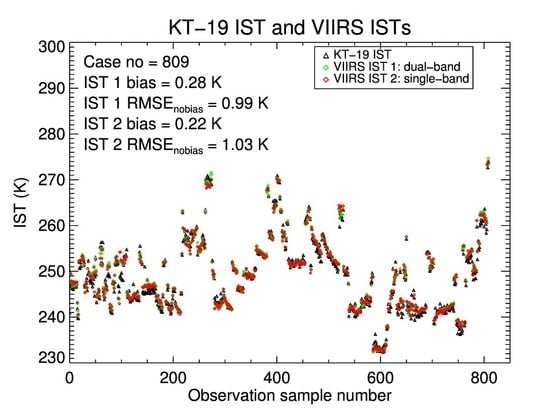1. Introduction
The surface temperature of sea ice, referred to as ice surface temperature (IST), is one of the most fundamental variables for assessing changes in Arctic climate [
1]. Ice surface temperature integrates changes in the surface energy budget, which controls sea ice growth/melt and the exchange of heat and moisture between the surface and the atmosphere. The Arctic is warming at a higher rate than the midlatitudes [
2], a pattern known as Arctic amplification. Accurate and consistent measurement of the ice surface temperature across the Arctic is key to understanding Arctic climate change. While measurements at the surface are critical to monitoring climate, they are sparse in polar regions. In contrast, satellite-derived ice surface temperature provides broad spatial coverage, frequent temporal sampling, and relatively high accuracy.
Algorithms have been developed to retrieve IST under clear conditions with longwave infrared bands from satellite imagers. A dual-band regression algorithm utilizes the brightness temperature difference between the “split window” 11 and 12 μm thermal bands to account for the atmospheric absorption [
3,
4]. This approach is most common, and has been applied to retrieve IST using data from the Advanced Very High Resolution Radiometer (AVHRR) [
3], the Moderate Resolution Imaging Spectroradiometer (MODIS) [
5], and the Visible Infrared Imager Radiometer Suite (VIIRS) onboard the Suomi National Polar-orbiting Partnership (S-NPP) satellite and the Joint Polar Satellite System (JPSS) [
6,
7]. Validation studies have shown good performance, with a root-mean-square error (RMSE) of 1.2 K or less [
5,
6,
8,
9,
10,
11,
12].
Single-band regression algorithms that use the 11 μm brightness temperature alone have also been developed to retrieve ice surface temperature, either for the lack of a 12 μm band in the earlier AVHRR sensors [
13,
14], or as a backup method if one of the VIIRS thermal window bands fails [
7]. Limited validation of these single-band approaches indicates performance similar to the dual-band method [
14].
Some practical applications would benefit from the ability to do single-band IST retrievals with high quality. The S-NPP and JPSS VIIRS instruments have 16 moderate resolution bands (M-bands) at 750 m and five “image” resolution bands (I-bands) at 375 m. The 16 M-bands include split-window bands, an 11 μm band (M15) with a wavelength range from 10.26 to 11.26 μm and a 12 μm band (M16) with a wavelength range from 11.54 to 12.49 μm. The five I-bands include a relatively broad 11 μm band (I5) with a wavelength range from 10.5 to 12.4 μm. The dual-band regression algorithms have been developed utilizing the M15 and M16 bands to retrieve IST at 750 m resolution [
6,
7]. Extensive validation studies have shown this product has an absolute bias less than 0.5 K and an uncertainty less than 1.0 K [
6,
10]. These IST products are key inputs for other VIIRS ice product algorithms, notably ice concentration and ice thickness [
15,
16].
While 750 m ice products are relatively high resolution by today’s standards, even higher resolution products are desirable for operational ice applications where small-scale features need to be resolved. VIIRS ice concentration and ice thickness products rely on IST, so it is necessary to create a single-band IST product. Similarly, Landsat 8 has been used in case studies of sea ice for its very high spatial resolution, with 30 m resolution for visible bands and 100 m resolution for thermal bands [
15]. An IST product from Landsat 8 using either a dual-band or single-band algorithm is desirable for studying sea ice in greater detail, and for deriving other products. Unfortunately, Landsat 8 band 11 (12 μm) has a large uncertainty, thus it is not recommended for quantitative analysis, including retrieval of surface temperature (
https://landsat.usgs.gov/landsat-8-data-users-handbook-appendix-a). Therefore, a single-band regression approach for Landsat 8 IST is also needed.
In this paper we formulate and validate single-band IST products for S-NPP VIIRS and Landsat 8 using high-resolution field survey mission IST measurements. The IST products and their uncertainty information will be useful for monitoring small-scale variations in surface temperature and for generating other high spatial resolution ice products with IST as inputs. We first describe the single-band IST algorithm and the validation dataset, then show the results of the validation.
2. Materials and Methods
The dual-band IST algorithm has the following form:
where
Ts is the estimated IST (K),
T11 and
T12 are the brightness temperatures (K) at 11 μm and 12 μm bands,
θ is the sensor scan angle, and
a,
b,
c, and
d are retrieval coefficients [
5,
8].
The single-band IST algorithm in previous studies has the following form:
where
Ts is the estimated IST (K),
a and
b are retrieval coefficients; and
T11 is the brightness temperature in the 11 μm band (K) [
13,
14]. The atmospheric absorption and surface emissivity effects are accounted for implicitly by the coefficients
a and
b. The IST in (1) and (2) is the “skin” temperature, or the radiative temperature of the surface. The ice surface is generally covered with snow, though it may also be bare ice or melt ponds in the summer.
Coefficients of the algorithms can be derived in two ways. One approach is to collocate the satellite brightness temperature with in situ IST measurements, and to determine the retrieval coefficients through linear regression as suggested in [
14]. However, collecting sufficient in situ IST measurements with extensive spatial and temporal representation over the sea ice is challenging. The other approach is the use of a forward model as in [
3], where a radiative transfer model is used with observed temperature and humidity profiles and a sensor’s spectral response functions to simulate the 11 and 12 μm brightness temperatures that would be observed under a broad range of conditions. We will apply the second approach in this study as described in the following. More details of this approach can be found in [
3,
4].
A total of 1338 atmospheric temperature and humidity profiles from 1976 to 1991 were sampled from three archives: the North Pole archive, the National Center for Atmospheric Research archive, and the Historical Arctic Rawinsonde archive [
17]. These include 553 profiles over the Arctic Ocean and 785 profiles from coastal weather stations. They are more or less evenly distributed over 12 months. All profiles have at least 10 levels of pressure, air temperature, and dew point temperature. VIIRS thermal band response functions for all bands were obtained from the National Oceanic and Atmospheric Administration (NOAA) at
https://ncc.nesdis.noaa.gov/VIIRS/VIIRSSpectralResponseFunctions.php. The Landsat 8 thermal band response functions were obtained from the National Aeronautics and Space Administration (NASA) at
https://landsat.gsfc.nasa.gov/preliminary-spectral-response-of-the-thermal-infrared-sensor/. Here the ice surface is assumed to be snow covered, and the wavelength-dependent snow emissivities were parameterized for all sensor scan angles following the procedure in [
18]. Thermal band radiances at 5 cm
−1 intervals for scan angels from 0° to 60° every 10° were simulated using the LOWTRAN 7 radiative transfer model [
19], with inputs of temperature and humidity profiles and snow emissivity. The temperature at the lowest layer is assigned as the ice surface temperature. The background tropospheric and stratospheric aerosols for subarctic winter and summer were used.
Simulated radiances were integrated for the thermal band based on its response function and then converted to brightness temperature. Linear regression was used to determine the coefficients
a,
b,
c, and
d in Equation (1) for Landsat 8, and
a and
b for S-NPP VIIRS I-band I5 and M-band M15, and Landsat 8 band 10 (11 μm) in Equation (2) for three 11 μm brightness temperature ranges: less than 240 K, 240–260 K, and 260–273 K. Values of the retrieval coefficients and their standard errors are given in
Table 1 and
Table 2. The coefficients for the S-NPP VIIRS dual-band algorithm can be found at
https://www.star.nesdis.noaa.gov/jpss/documents/ATBD/ATBD_EPS_Cryosphere_IST_IceCover_v1.0.pdf. It should be noted that the M15 band covers wavelength from 10.26 to 11.26 μm, while the I5 band has a broader wavelength range from 10.5 to 12.4 μm. Retrieval performance of the single-band algorithm for M15 and I5 may be different due to the differences in wavelength range, although the spatial resolution of retrieval products using I5 band is higher.
Cross-validation was used to test the performance of the retrieval algorithms. Of the 1338 profiles, 90% were randomly selected to derive the dual-band and single-band retrieval coefficients for Landsat 8 and VIIRS, and the remaining 10% were used to determine the bias and standard deviation (RMSE
nobias). This process was repeated 100 times. The statistics are shown in
Table 3. For the single-band retrieval algorithm in Equation (2), the retrieval biases have a sensor scan angle dependence, e.g., biases range from 0.202 to −0.480 K for Landsat 8, from 0.269 to −0.699 K for VIIRS M15, and from 0.344 to −0.819 K for VIIRS I5 with sensor scan angles from 0 to 60 degree. Also, the differences of retrieved and true surface temperature appear to have linear relationships with column total water vapor (
Figure 1). It should be noted that such an angle dependence and linear relationship between retrieval bias and total water vapor for Landsat 8 (
Figure 1) and VIIRS (similar as that of Landsat 8, not shown) do not exist for the dual-band retrieval algorithm, as shown in
Table 3 and
Figure 1. These features suggest an addition of an extra term in the single-band retrieval equation could account for the sensor scan angle dependence. We propose an updated single-band IST retrieval equation:
where
Ts is the estimated IST,
a,
b, and
c are retrieval coefficients,
T11 is brightness temperature at 11 μm band, and
θ is the sensor scan angle. The retrieval coefficients are derived in the same way described above. The addition of the new term alleviates the sensor scan angle dependence of the retrieval bias and the linear relationship between retrieval bias and total water vapor (
Table 4,
Figure 2). The retrieval coefficients for Equation (3) are listed in
Table 5, with their standard errors given in parenthesis.
The primary validation dataset in this study consists of IST measurements made with an airborne Heitronics KT-19.85 Series II infrared radiation pyrometer, hereinafter simply “KT-19”, flown on a NASA P3 aircraft during the NASA Operation IceBridge campaigns (
https://www.nasa.gov/mission_pages/icebridge/mission/) [
20]. The surface temperature measured by the KT-19 is provided by the IceBridge science team in a dataset available from the National Snow and Ice Data Center (NSIDC;
https://nsidc.org/data/iakst1b). The KT-19 measurements have a temperature resolution of ±0.1 °C and an accuracy of ±0.5 °C plus 0.7% of the difference between target temperature and KT-19’s internal temperature [
21] (
https://www.wintron.com/heitronics-kt19-infrared-thermometer). The internal temperature may vary as much as 30 °C during the course of a flight; no correction for these changes has been applied to the KT-19 surface temperature data. The P3 aircraft usually flies only a few hundred meters above ground level, so atmospheric absorption is minimal because of the low water vapor content over sea ice, though it may not be negligible. In deriving surface temperature from KT-19 measurements, the IceBridge science team used a surface emissivity of 0.97 starting in 2012. Before 2012, a surface emissivity of 1.0 was used. This change by the IceBridge team suggests that 0.97 provides the best estimate of surface temperature [
21]. More details of KT-19 surface temperature measurements can be found in IceBridge Data Products Manual [
21]. All these factors contribute to the overall uncertainty in the KT-19 measurements, which has not been assessed extensively. Previous validation studies show close agreement between KT-19 measurements and dual-band IST retrievals [
6,
10], and between dual-band IST retrievals and other validation data sets [
5,
8,
9,
11,
12], which indicates the usefulness of KT-19 measurements in IST validation.
All available cases of KT-19 observations in the Arctic from 2013 to 2017 were used to validate the collocated S-NPP VIIRS and Landsat 8 retrieved IST [
22]. Also, a rigorous visual check of both cloud mask products was done to ensure that only clear observations were used. The VIIRS and Landsat 8 cloud masks and a visual inspection of the data were applied to eliminate cloudy and foggy cases for both satellite datasets and the KT-19 [
23]. All available KT-19 temperature measurements within 100 m (Landsat) or 375 m (VIIRS) of the center of the pixel were averaged. The maximum time difference for matchups between KT-19 and S-NPP VIIRS and Landsat 8 was 60 min. This time difference can contribute to the overall differences between the satellite-retrieved IST and the KT-19 temperature shown below due to surface temperature changes over 60 min.
3. Results
On 19 March 2014 from 2237–2238 UTC, a concurrent Landsat 8 overpass and an Ice-Bridge P-3 flight off the Northwest coast of Alaska near Point Lay were acquired (
Figure 3). Only clear pixels over sea ice in Landsat 8 were used in analysis. The clear area was determined with the cloud mask, a high value of the Normalized Difference Snow Index (NDSI), and visual inspection. Comparison with KT-19 measurements showed a very small overall cold bias of −0.03 K, and an RMSE
nobias of 0.76 K (
Figure 4). Towards to the end of the KT-19 track, possible cloud contamination near cloud edges in the Landsat 8 data led to lower retrieved IST (
Figure 3 and
Figure 4).
A mostly clear scene over the Beaufort Sea when an Ice Bridge flight coincided with a S-NPP VIIRS overpass on 30 Mar 2015 was also analyzed (
Figure 5). The S-NPP VIIRS derived IST from the M-band dual-band approach [
6], and from the single-band approach using the I5 band (11 µm) covered the same area. The dual-band IST was quality controlled to screen out clouds with the VIIRS M-band cloud mask (there is no I-band cloud mask) and visual inspection (
Figure 5); I-band IST used the same cloud screening. Compared to the dual-band IST, the single-band IST at image resolution shows more detail of the sea ice leads (fractures) because of its higher spatial resolution. The time difference of KT-19 and VIIRS ISTs was 30 min or less for the comparison in
Figure 6 and
Figure 7. The inter-comparison of VIIRS retrieved IST and KT-19 IST showed very small biases and RMSE
nobias for both approaches, with a bias of 0.29 K and RMSE
nobias of 0.58 K for the dual-band approach and a bias of −0.14 K and RMSE
nobias of 0.62 K for the single-band approach.
Besides the case studies, we also collected all 809 collocated cases of KT-19 and VIIRS ISTs from 2013 to 2017 covering a large area of the Arctic. For easier comparison, both dual-band and single-band VIIRS ISTs were calculated using the M-band brightness temperature. The comparison results are shown in
Figure 8. A comparison of these 809 collocated KT-19 IST measurements and VIIRS derived ISTs gave an overall bias of 0.28 K and a RMSE
nobias of 0.99 K for the dual-band algorithm, and an overall bias of 0.22 K and RMSE
nobias of 1.03 K for the single-band algorithm. The positive biases for both approaches increased slightly with increasing 11 μm brightness temperature. To investigate the remaining impacts of the atmospheric effect in the retrieval bias we calculated the correlations between the retrieval bias, the difference of retrieved IST and KT-19 IST, and KT-19 IST, which is a proxy of total column water vapor. The correlations are −0.08 and −0.13 for dual-band and single-band algorithms, which indicates that the atmospheric effect can only explain 0.6% and 1.7% of the variance in the retrieval bias for dual-band and single-band algorithms. Both algorithms compensate for the atmospheric effects reasonably well. Calculations also show that both bias and RMSE
nobias are not dependent upon the satellite sensor scan angle.
4. Discussion
Comparison of satellite-derived IST with KT-19 measurements has its limitations. The spatial resolutions of VIIRS and Landsat 8 pixels at nadir are 375 m for the I-bands (750 m for M-bands) and 100 m, respectively, while the KT-19 is a 15 m point-track observation. The collocation of derived ISTs and averaged KT-19 measurements are not always optimal, as the observations of VIIRS, Landsat 8 and KT-19 are not always concurrent in time and cloud contamination may introduce biases and larger uncertainties in the satellite-retrieved ISTs.
Our use of LOWTRAN 7 is primarily a function of heritage, as our earlier work also used this model [
3,
4]. More advanced radiative transfer models are available, primarily providing higher spectral resolution, e.g., the community radiative transfer model (CRTM) and MODTRAN5 [
24,
25]. Previous tests with MODTRAN5, however, did not indicate that the resulting IST regression coefficients would result in significantly more accurate retrievals.
The dual-band retrieval approach is expected to perform better than the single-band approach because the split-window difference accounts for atmospheric absorption, especially under warmer and more moist conditions. The single-band retrieval approach is therefore expected to be more sensitive to the atmospheric effect and surface emissivity variations. However, results in this study show that both single-band and dual-band retrieval biases do not have an apparent dependence on total column water or sensor scan angle. This might be due to (1) both algorithms have a term related to the sensor scan angle specifically to account for the scan angle and column water vapor effects; and (2) the column water vapor in the Arctic is low, thus its effect on the retrieval is small. In deriving the retrieval coefficients, surface emissivity is prescribed as a function of satellite viewing angle. Snow emissivity changes with snow grain size and shape, and thus depends on surface snow type [
26]. Both single-band and dual-band algorithms have been developed to retrieve land surface temperature with an explicit dependence on the surface emissivity [
27]. With prior knowledge of surface type and thus surface emissivity, a similar approach can be applied to retrieve the ice surface temperature. Whether this algorithm can be used to retrieval surface temperature over other surface types needs further investigation [
28].
It should be acknowledged that there has not been a robust assessment of the uncertainty of the KT-19 surface temperature measurements. The overall bias and RMSEnobias of the single-band and dual-band IST retrievals may need to be refined when additional information becomes available on the KT-19 absolute bias and uncertainty. However, the lack of information on the absolute KT-19 surface temperature uncertainty does not change the conclusion of this study that the single-band IST retrieval approach can provide results comparable to traditional dual-band IST retrieval approach.
In this study the retrieval coefficients were derived using atmospheric profiles in the Arctic, and performance of the retrievals were evaluated with KT-19 measurements in the Arctic. The application of the same retrieval algorithm on sea ice in the Antarctic is valid because of the similar surface snow type and relatively low water vapor content in the Antarctic. For the same reason, the retrieval algorithm may be applicable to estimating lake ice surface temperature. However, the application of the methods described above over the Antarctic continent and over lake ice needs to be evaluated using in situ measurements and other remote sensed observations with comparable or higher spatial resolution (for example KT-19 measurements) in order to obtain a quantitative assessment of the retrieval algorithm performance. It is possible that new retrieval coefficients would be needed based on atmospheric profiles collected over high-altitude portions of Antarctica and over or near lakes.
